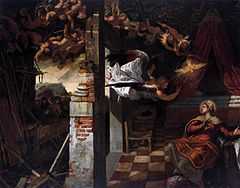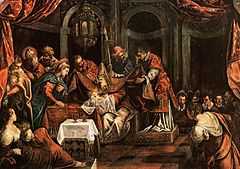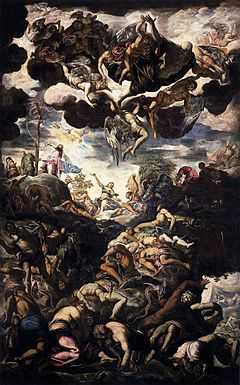Scuola Grande di San Rocco
The Scuola Grande di San Rocco is a building in Venice, northern Italy.
History
The Scuola di San Rocco ("Confraternity of St. Roch",[1] protector against plague, which had struck Venice in that century) was established in 1478 by a group of wealthy Venetian citizens, next to the church of San Rocco, from which it takes its name.
In January 1515 the project of the building was entrusted to Bartolomeo Bon, although some authorities assign it to his son Pietro Bon. In 1524 his work was continued by Sante Lombardo, who, in turn, three years later was replaced by Antonio Scarpagnino. Following his death in 1549, the last architect to work on the edifice was Giangiacomo dei Grigi, finishing in September 1560.[2]
The design was similar to other scuole in Venice, characterized by two halls, one at ground floor level, the other at first floor level. The Sala Terra (lower) has a nave and two aisles, with the entrance from the campo[3] outside. From this hall a stair (with a landing surmounted by a dome) led to the upper storey. The Sala Superiore ("Upper Hall") was used for meetings of the fellows and had a wooden altar. It provided access to the Sala dell'Albergo, which housed the Banca and the Zonta (the confraternity's supervisory boards).
Art



In 1564 the painter Tintoretto was commissioned to provide paintings for the Scuola, and his most renowned works are to be found in the Sala dell'Albergo and the Sala Superiore. All the works in the building are by him, or his assistants, including his son Domenico: they were executed between 1564 and 1587. Works in the sala terra are in homage to the Virgin Mary, and concentrate on episodes from her life. In the sala superiore, works on the ceiling are from the Old Testament, and on the walls from the New Testament. Together, they show the biblical story from Fall to Redemption.
Main works include:
- Sala Terrena (complete list)[4]
- Annunciation
- Adoration of the Magi
- The Flight into Egypt
- The Slaughter of the Innocents
- Presentation in the Temple
- The Assumption of Mary
- St Mary Magdalen
- St Mary of Egypt
- Sala Superiore (ceiling)[5]
- Adam and Eve
- Jacob's Ladder
- God Appears to Moses
- The Passover
- The Pillar of Fire
- The Fall of Manna in the Desert
- Moses Strikes Water from the Rock
- Miracle of the Bronze Serpent
- Elijah is Fed by the Angels
- Elisha Distributes Bread
- The Vision of the Prophet Ezekiel
- Sala Superiore (walls)[6]
- The Adoration of the Shepherds
- The Baptism
- Christ Tempted by Satan
- Christ Heals the Paralytic
- Multiplication of Bread and Fishes
- The Resurrection of Lazarus
- The Last Supper
- The Agony in the Garden
- The Resurrection
- The Ascension
- Wooden: episodes of the Old Testament by Giuseppe Angeli
- Sala dell'Albergo[7]
- Allegory of St. John's Guild
- Allegory of St. Mark's Guild
- Allegory of St. Theodore's Guild
- Allegory of the Charity Guild
- Allegory of the Misericordia (Mercy) Guild
- Christ Before Pilate
- Ecce Homo (The Crowning with Thorns)
- Ascent to Calvary
- The Crucifixion
Other works present include paintings by Titian and Palma il Giovane.
Notes
- ↑ Although the term "scuola" also referred to the building housing their seat.
- ↑ Scuola Grande Arciconfraternita di San Rocco Guide leaflet (in English), page 2
- ↑ Name of the Venetian squares.
- ↑ Scuola Grande Arciconfraternita di San Rocco Guide leaflet (in English), page 3
- ↑ Scuola Grande Arciconfraternita di San Rocco Guide leaflet (in English), page 3
- ↑ Scuola Grande Arciconfraternita di San Rocco Guide leaflet (in English), page 3
- ↑ Scuola Grande Arciconfraternita di San Rocco Guide leaflet (in English), page 3
References
- Zenkert, Astrid. Tintoretto in der Scuola di San Rocco, Ensemble und Wirkung. T1918-4: Ernst Wasmuth Verlag.
- ?Wittmann, Heiner (1996). Sartre und die Kunst. Die Porträtstudien von Tintoretto bis Flaubert. Tübingen: Gunter Narr Verlag. ISBN 3-8233-5167-2.
External links
- Official website (Italian) (English)